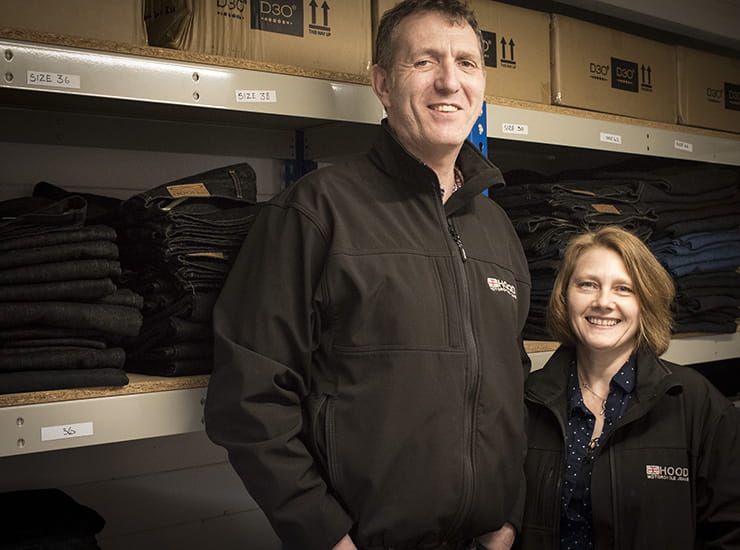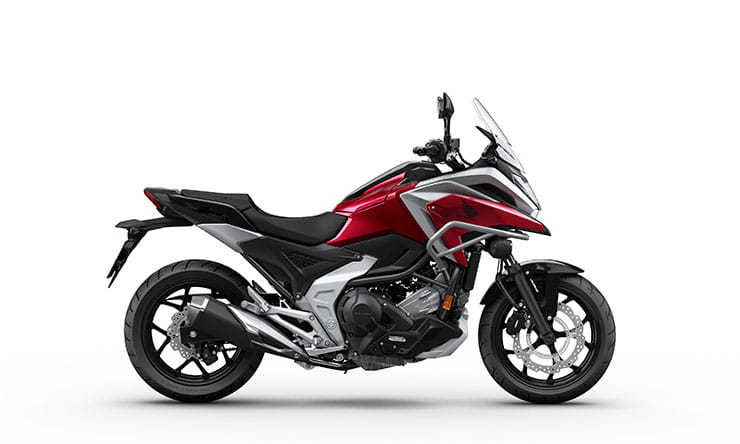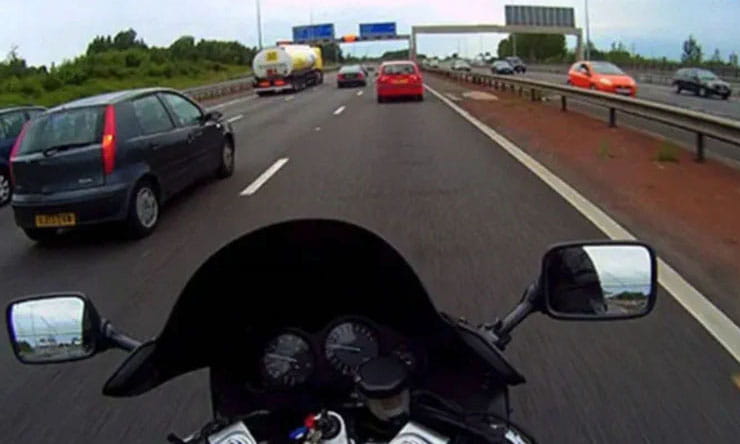Chris and Julie Easterford formed Hood jeans after meeting in Chris’ father’s jeans factory
For more than 20 years, Chris and Julie Easterford have been designing and making Hood protective motorcycle jeans in Norfolk. Their fully-lined kit has been the choice of thousands of bikers around the world, as well as many journalists (this one included).
In 2016 I was writing a feature about the upcoming changes to the CE standards for motorcycle clothing – which would all be deemed Personal Protective Equipment (PPE) from 21 April 2018 – and called Chris for a comment on how the legislative changes would affect his family business. It was a call that had huge implications for the couple and their much-loved brand…
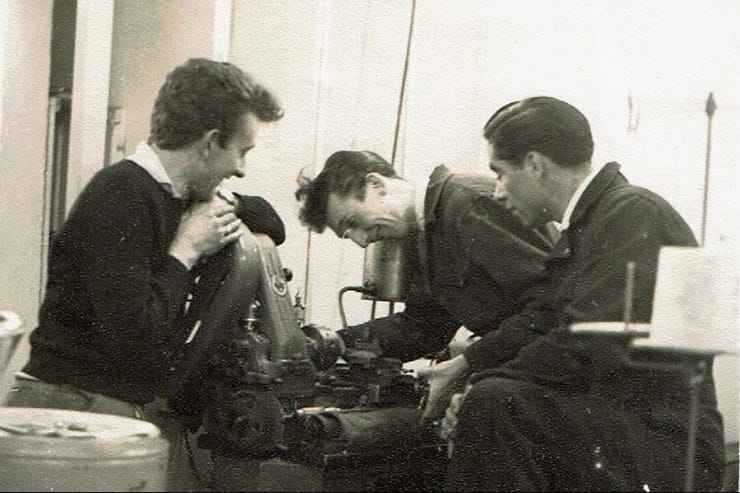
Lee Cooper’s jeans success was thanks in part to the rationing of clothing in the 1950s. Tom Easterford is in the centre of this shot
A brief history of Hood motorcycle jeans
Chris’ father Tom started work at Lee Cooper after the war, when the jean industry really took off thanks to denim trousers being deemed as workwear, so requiring fewer ration tokens to buy. He was making tens of thousands of pairs a week, before leaving in the late 1950s to start Falmers Jeans, then setting up Motown jeans in the 1960s.
Chris went to work at Motown in the early ’80s where he learned production, cutting and the whole industry. His wife Julie joined the company around 1985, and the couple left together in 1994 to set up their own business designing for major high street names – creating the patterns and early samples before handing them over for full scale production.
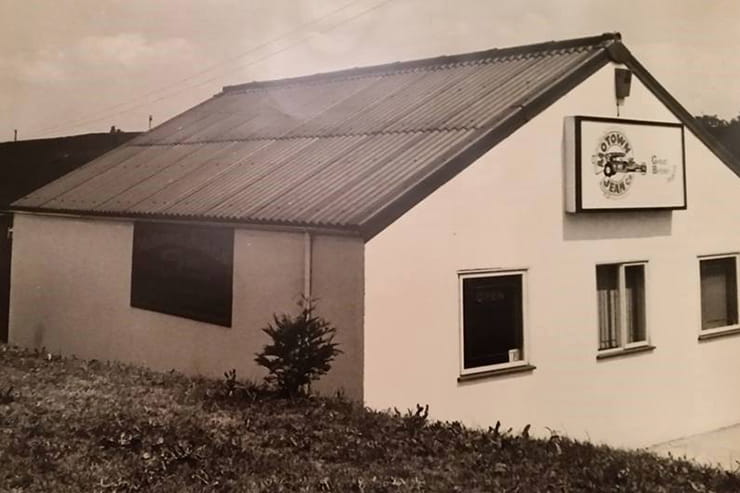
Chris and Julie met at his Dad’s Motown jeans factory
At the same time, Chris’ Dad was making paddock wear for motocross teams; when he closed his factory in 1996, Chris and Julie took on some of the contracts and started designing motocross clothing with Kevlar, Cordura and ballistic nylons; they were using the Kevlar to protect the other materials from the heat of the exhaust at the time. Again, Chris and Julie would design the patterns, grade them (make templates for each size), and produce 100 or so samples before the client – SoCal – took them into mass production.
After a couple of years, Chris and Julie started considering using Cordura – which claimed to be tougher than leather – to make their own brand of motocross jeans, but everyone they spoke to said that the sponsorship deals already in place would make it almost impossible to break into. So they looked at the road-riding market…
Motorcycle jeans for UK road riders
“In 1998 the first Hood jeans were made – we came up with a normal five-pocket western-style jean, but made out of Cordura, with an airflow lining,” Chris tells me. “They were selling, but people really wanted them to look more like typical jeans... We knew how to make a denim jean, so within six months we produced the K7 with Cordura inside.
“It sold well, but we lost faith in Cordura and moved to using DuPont’s para-aramid fibre, Kevlar, to produce the first fully-lined para-aramid jeans – all around the front and back, right down to the calf. At the time, the other brands were only using protective panels.
“By experimenting with various weaves and knits of Kevlar, as well as other materials, we learned a lot about the protective qualities that could be achieved.
“From the late 1990s, our customer was typically a classic bike rider. I remember going to Snetterton to hand out leaflets, but nobody wanted to give us the time of day. Now many sportsbike riders also have a pair of protective jeans, and of course the street bike and custom scenes have transformed the market.
“We’ve grown organically, but never exploded – we’re not sales people, having simply relied on our product to do the talking.”
Hood has always been based in Norfolk, Chris and Julie designing and adjusting all the jeans that they sell (leg length adjustments are free) and only sub-contracting some of the construction – to a family business in Leicester – when demand got extremely high.
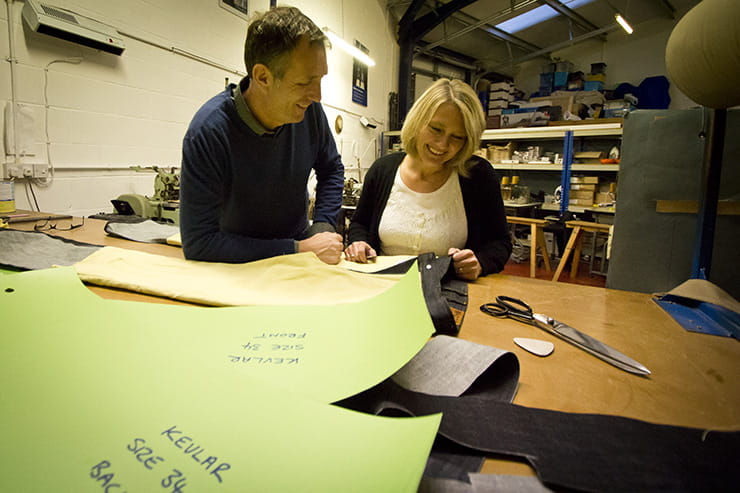
Chris and Julie always have, and always will, produced the templates for their bike jeans
How CE legislation transformed Hood
It was in Spring 2016 that I called Chris to ask how he thought the new CE standards would affect a small company like Hood. You can read the full details of the new legislation here, but briefly, from 21 April 2018, ALL motorcycle clothing is deemed Personal Protective Equipment (PPE), so must be tested to comply with PPE Regulation 2016/425.
“Business was going really well when you called,” says Chris. “We had heard rumours of the new CE standards, but to be honest we’d completely ignored them. Everything was very loose, and we’d had no information like you gave us. We’d already made a decision not to chase the current CE standard [EN 13595] – our G8 jean for instance could have been CE-approved, and we had meetings at UK test house SATRA, but it’s not in any testing company’s remit to give advice. We knew we were beating the abrasion, tear and seam strength standards, but we didn’t have anyone to push us through the technical details of the approval process, and believed we were best producing a lightweight jean that was easy to wear.”
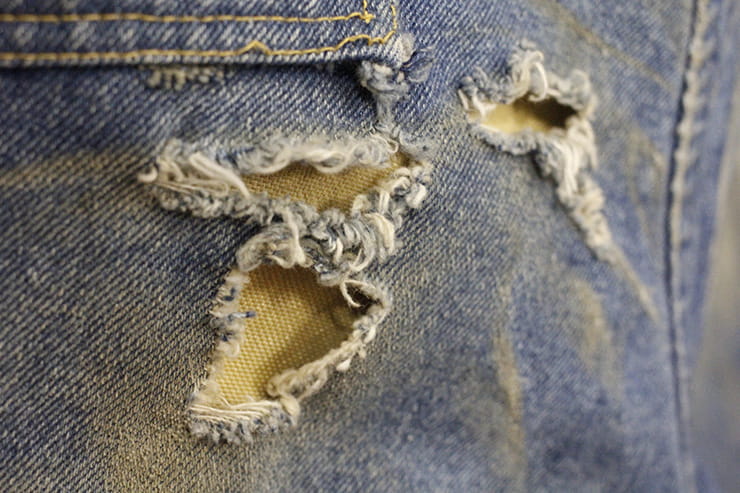
Hood regularly carried out testing of its jeans, as well as talking to customers who’d crashed in them
As editor of Motorcycle Sport & Leisure magazine, I’d previously been working with Paul Varnsverry, Technical Director of PVA-PPE Group – a company giving advice to companies worldwide whose products (from motorcycling to gardening) need to meet CE standards – so put Chris in touch with him.
Chris continues: “I was still of the attitude that the changes would be something we could work around, and the Brexit referendum had just happened, so I also wondered if it would be relevant at all in a few years. But I phoned Paul and soon realised it was something we absolutely had to deal with.
“At first I spoke to Paul more like a wheeler-dealer type of guy, looking for the way out, but he made it very clear that Trading Standards would be able to stop us doing business. It was impossible to ignore. We weren’t looking for loopholes to avoid safety, it was simply the costs and time that would be involved, then passed onto the customer. We’d always done a lot of testing of our own, along with crash reports from customers and independent testing from SATRA.”
Chris and Julie’s attitude to business is best summed up by the fact that they won’t give discounts – not out of greed, but purely because they want everyone to pay a fair price. “I’d hate to over-price something so it could be reduced for one person, but have a pensioner come to us and pay top whack without quibbling. We’d spent 20 years building up trust, and firmly believe in the quality of what we made.
“I met Paul with a list of questions in September 2016, and we spent four days working together, both from different sides of the fence. I took a lot of my own test data, and together we challenged a lot of things. I came away firmly believing that we had to move quickly, but that we could also produce an even better product.
“Finally, we had someone who could give us the advice we really needed – we probably would have done this a long time before if we’d known Paul, and we’re also well aware that without his help, Hood wouldn’t have been able to continue.”
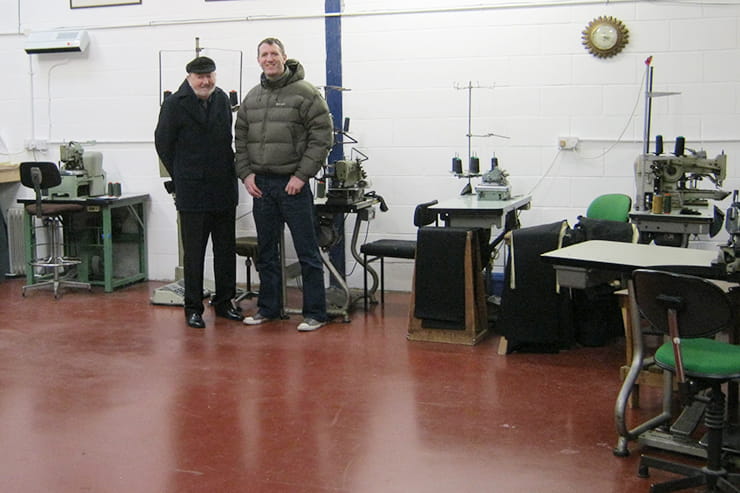
Chris at Hood’s Attleborough factory with his father in 2015, just before he sadly passed away
Meeting the new CE standards
“It’s the technical documents that make things so hard in meeting CE standards,” says Chris. “We can make anything, but it’s understanding everything from the zones that are used for testing, to the paper trail of every product used in construction.
“While we’ve always used top quality denim, the supply chain has often changed from one year to the other; that can’t happen to meet CE approval. A product is certified with its parts – zips, poppers, materials etc – and its exact construction methods.”
As the standard that needed to be met for CE approval was provisional while Hood was designing its new jeans, like many other companies it faced real hurdles as from one week to another requirements could change, moving the goal posts. In some ways, being such a relatively small company with basically one product to worry about was a benefit, as it was possible to adapt more quickly.
Complying with the new legislation cost the family more than £10,000. It’s also meant that some of the products will drop from the range, like the cargo pants – while Chris argues that these have saved many of his customers, the new standardised test method looks only at whether the outer material can be compromised, regardless of the layer beneath – in Hood’s case, a tough para-aramid. Development work could have seen the seam designs and materials tweaked, but it just wasn’t economically viable.
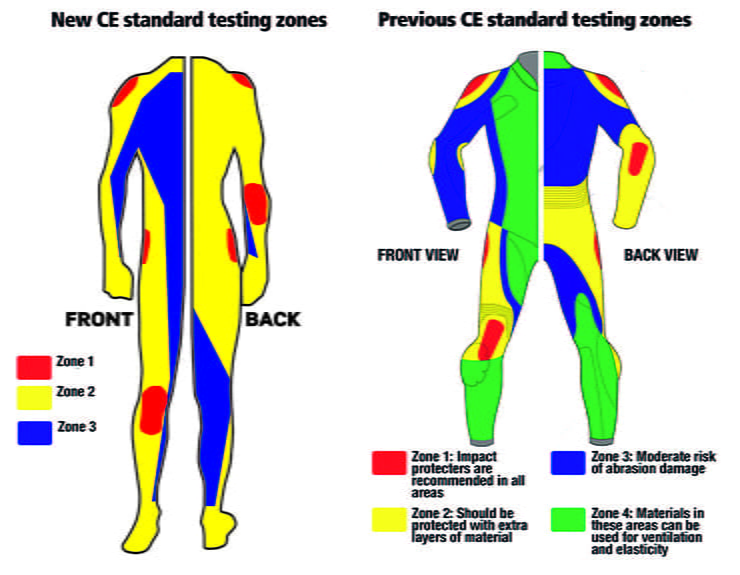
Understanding the zoning of the prEN 17092 is just one challenge of meeting CE standards
“While there were a lot of challenges,” says Chris, “ultimately this was a chance to make an even better garment. Then we had a choice – go even lighter with our jeans and be CE-approved, or make something more protective, within the limits of what we believe to be comfortable.
Difficult decisions
“During the meetings with Paul,” says Chris, “I met a manufacturer in China who could supply a double-thickness jersey knit of para-aramid that would exceed the levels of protection we already had, without making the jeans any less wearable.
“Like any company, we’ve always bought materials from around the world. The construction of the fabric we found available in China was so good that it could offer much more protection than we were then using, which meant we could keep the weight down for a more comfortable jean.
“While we knew we’d need to – and would benefit from – changing some suppliers, we’ve always intended to continue making Hood jeans here in the UK. As the company has grown it’s become increasingly difficult though, leading for instance to problems with laundering of the denim here in the UK that meant we had to throw away almost £20,000 worth of stock; as we pushed our partners harder, more things went wrong. Julie and I were working six or seven days a week at the machines and it was taking its toll.
“Paul had suggested that we could benefit from have our jeans made in China, but we were always against it. Out of courtesy I spoke online to Mr Geng, the manager of a very highly-respected factory that Paul introduced me to, then eventually agreed to go to China and meet him in person.
“When I got back from that meeting, Julie and I talked a lot about the new regulations and what they’d mean to us to produce in our factory, not to mention the amount of sampling we’d need to carry out. Our partner in Leicester also only had experience of motorcycle clothing with us, so would be very limited when we shifted to the much more labour-intensive construction involved in the design of our new CE-approved K7 Infinity jean.
“I met the Mr Geng again at the Intermot motorcycle show in Cologne, and some of the construction methods and fabrics he showed me were outstanding. He came to visit our factory, then I went back to China with my development samples to show the specific things that were really important to us. He got it straight away; it was fantastic to be working with such professional people who truly understood the needs of the specialist safety materials we’d be dealing with.
“We were exceeding our production capacity so were working all day every single day, our UK production costs had risen 30% and the new legislation meant that construction would be even harder, slower, and more expensive – to be honest, the seam types we wanted to do just wouldn’t have been possible for us. Our fear was that if we carried on as we were, we wouldn’t be able to supply the quality of product we wanted, and the price we’d have to charge would be way too high. It was going to be a difficult decision to make, but it made absolute sense. If we did move production to China, Julie and I would still be designing everything ourselves, we’d still be making the adjustments to the finished products for each customer, and we’d still be sending each and every one out from our base in Norfolk. All that would change would be the machine used to assemble the materials, which had always been sourced globally.
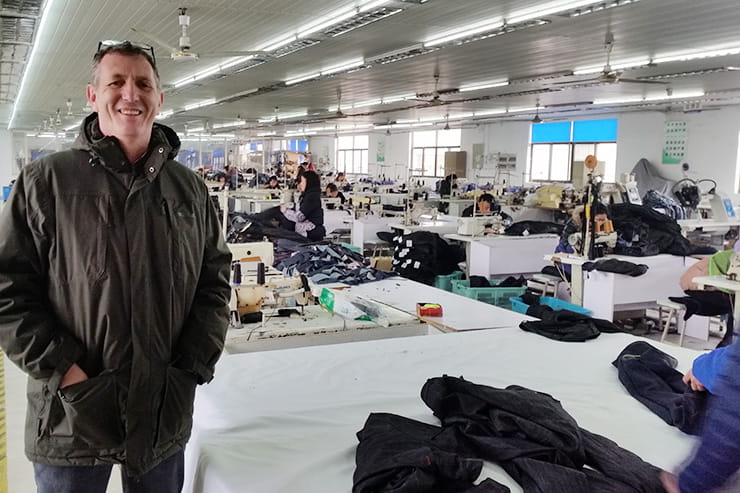
Chris on one of his many visits to the motorcycle PPE specialist factory in China
Around the middle of 2017, as they wrestled with the choices that would determine their business’ future, Chris and Julie’s world came crashing down around them.
Chris found himself in hospital after the huge hours they’d been working, and discovered serious heart problems. Doctors told him he had just a 50/50 chance of living for five more years. If he could reduce the stress on his heart, he could get a 25% chance of surviving for 10 years. The decision to move production was made.
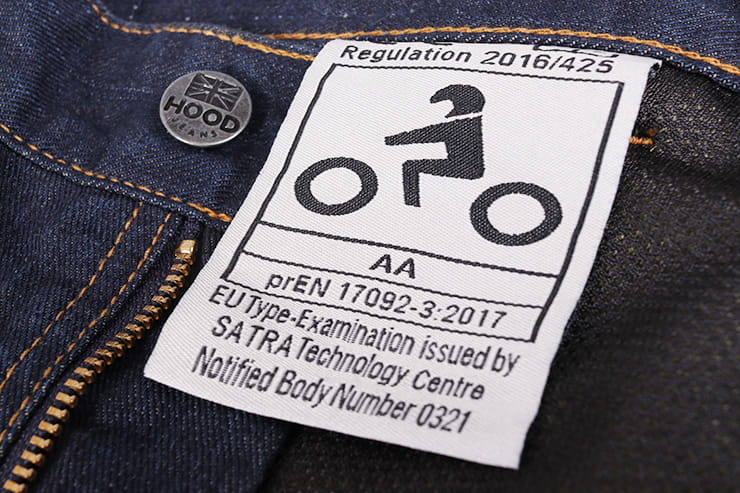
After a huge amount of work, Chris and Julie are proud that Hood’s new K7 Infinity jeans are CE-approved
“The new K7 Infinity we’ve produced is, we believe, the first jean approved to the new EU standard, and it meets AA classification. The layering of materials we’ve used is capable of meeting the top AAA rating, but the liners would have to cover the groin and go right to the very bottom of the leg, all the way around. We’ll do that for a new G8, but this product sits with our belief in making something that’s got a good balance of comfort and protection. It’s no good having clothing that beats all the targets on paper if you’re not going to actually wear it.
“I go to the factory in China very, very regularly to make absolutely sure that the construction is always up to the standard we expect,” says Chris, “and that the working conditions are good – they are in fact better than we’d seen in this country, and the quality of workmanship is exceptional. I shouldn’t have been surprised, as the factory is a specialist in CE-approved motorcycle kit.
“It’s hard to say, but the build quality is even better than we’ve been able to do in the past 20 years.
“I do miss the machines we had in our factory, and love walking around the new site, listening to the machines working; the staff get nervous that I’m going to criticise them, but I’m just enjoying being there. Julie and I are so happy with the people working alongside us, and so proud of what we’ve produced.”
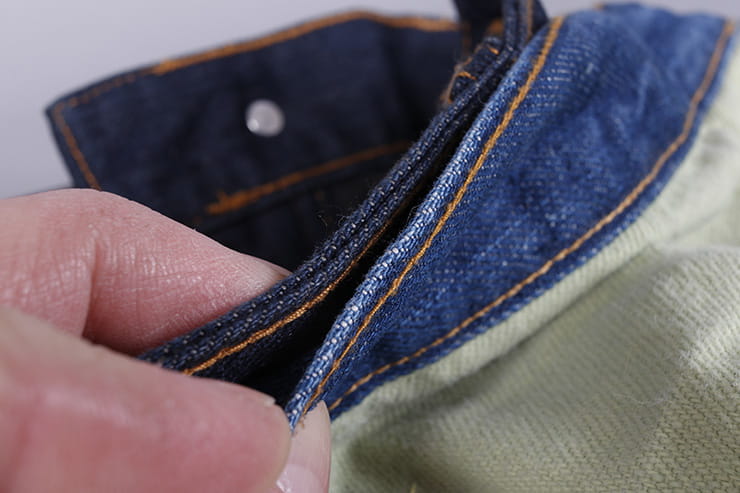
Looking closely, the construction of the new K7 (left) is even better than the previous model (right)
“Our certification process included many discussions with Paul and SATRA here in the UK. We have a 30 page document that declares the conformity of our jeans – they were tested in Spain, approved in the UK, the materials are sourced globally from certified manufacturers, they’re fully designed and templated in Norfolk, and our factory here in Norfolk is also certified for the adjustments we make before each pair is sent to each customer.”
Hood jeans is still very much a cottage industry product made by a family in the UK. Chris and Julie have had to make some tough choices, but they’re choices that ensure the brand can continue to grow, that the family has more time together, and that the product is even better than it was. Ultimately, the new PPE legislation has benefitted everyone.
www.hoodjeans.co.uk
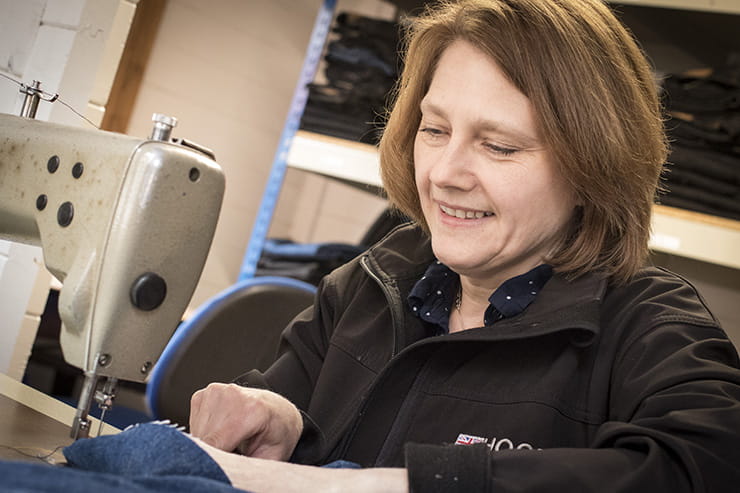
Every pair of Hoods are adjusted to suit the customer by Chris and Julie in Norfolk before they’re sent out


